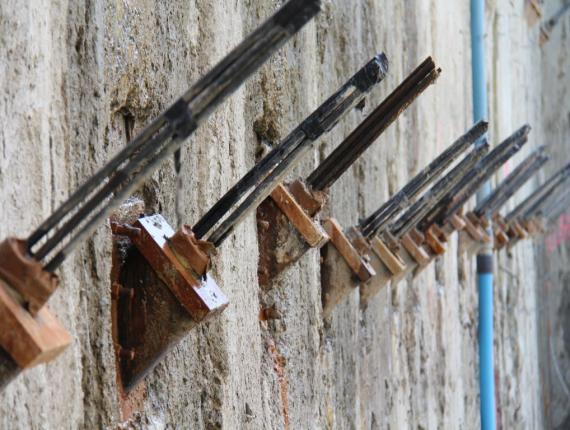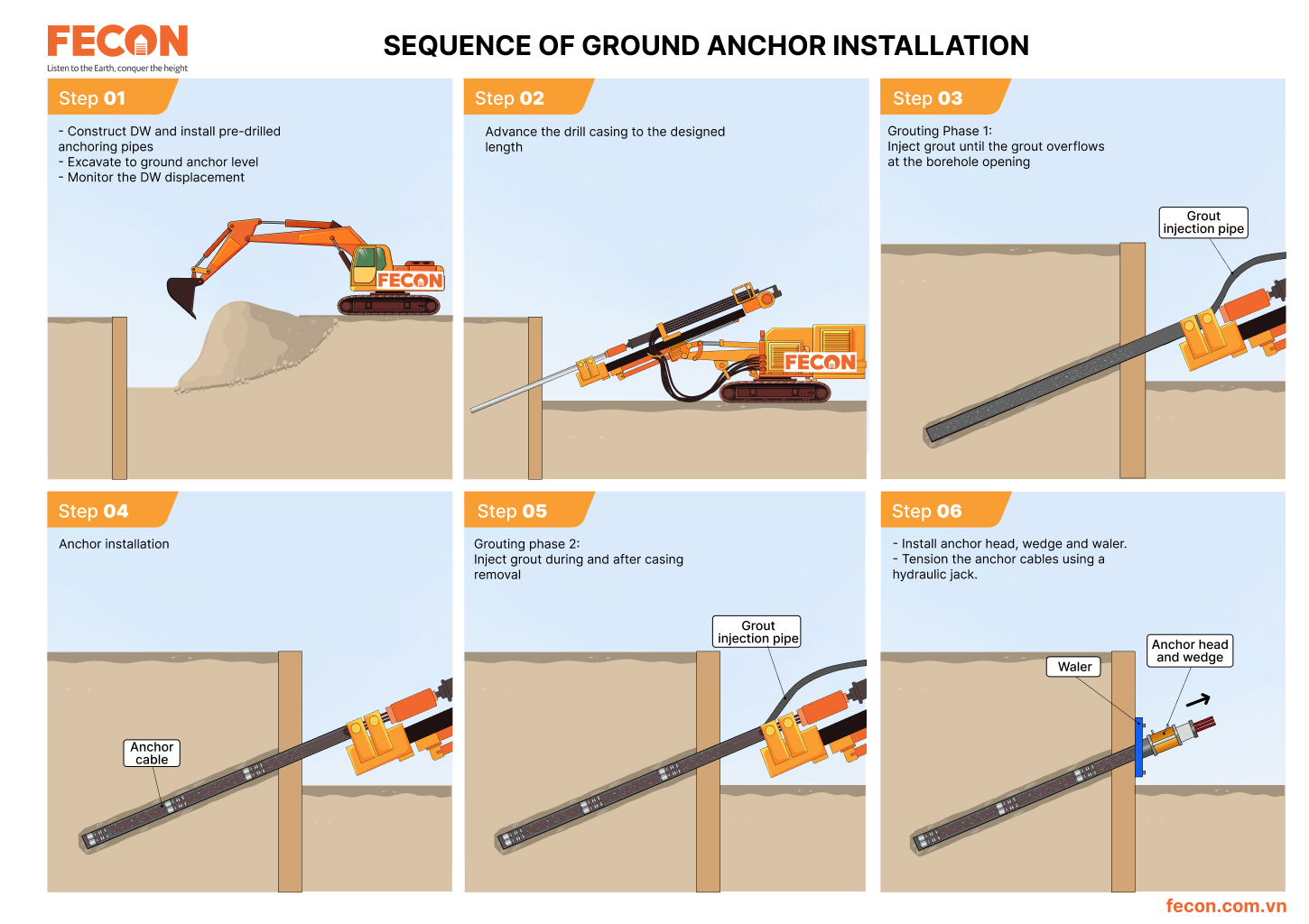Exactly How Sturdy Earth Anchors Job: A Comprehensive Overview to Dirt Anchoring Solutions
Heavy-duty Earth anchors play an essential role in giving stability and assistance in various building and construction applications. By embedding deeply right into the ground, they resist upright and lateral pressures successfully. Different sorts of anchors satisfy various dirt problems, making them functional. Recognizing their mechanics and installment techniques is crucial for taking full advantage of performance. What factors influence their performance, and exactly how do they compare to conventional techniques? The answers may stun you.
Understanding Heavy-Duty Earth Anchors
Heavy-duty Earth supports work as essential parts in numerous building and landscape design jobs, providing stability and support in challenging dirt conditions. These anchors operate by being installed into the ground, where they stand up to upright and side pressures. Their style enables safe add-on to structures, ensuring they continue to be anchored against soil motion or external loads.The effectiveness of durable Earth supports largely depends upon the kind of dirt and the anchor's installment deepness. Proper installment methods are crucial, as they establish the anchor's holding capacity. Environmental elements, such as wetness and freeze-thaw cycles, can likewise influence performance.These anchors are often made use of in applications varying from securing fences and preserving wall surfaces to stabilizing momentary structures during damaging climate condition. Recognizing the principles behind heavy-duty Earth anchors is important for specialists seeking to boost the sturdiness and safety of their jobs.
Sorts Of Heavy-Duty Earth Anchors
Numerous kinds of sturdy Earth supports are made to meet certain needs based on soil conditions and task needs. Helical anchors, including screw-like blades, work in softer soils, offering high tons abilities and simple setup. Driven anchors, which are inculcated the ground, appropriate for rough surfaces and offer prompt lots support. Tie-back anchors are commonly used in keeping wall surface applications, enabling lateral assistance by securing right into the ground at an angle. One more kind is the cast-in-place support, suitable for concrete applications, as they are incorporated into structures for enhanced stability. Ultimately, dirt screw anchors are flexible options that can be made use of in various dirt types, offering trusted tension and compression capabilities. Each type offers distinctive applications, guaranteeing security and security in construction and landscaping projects. Understanding these alternatives enables informed decisions in selecting the suitable Earth securing service.
The Mechanics of Soil Anchoring

Recognizing the technicians of dirt anchoring needs an exam of different sorts of Earth anchors and their setup techniques. Each anchor type provides distinct characteristics that affect its performance in different soil problems. Proper installment approaches are essential for optimizing the securing system's security and efficiency.
Kinds of Earth Anchors
Earth anchors, important parts in soil anchoring systems, been available in several kinds, each developed for certain applications and soil conditions. The most typical types consist of screw anchors, which are turned right into the ground, offering solid side resistance. Helical supports feature blades that permit for efficient setup in various dirt kinds, making them ideal for both permanent and temporary applications. Driven anchors, usually made from steel, are inculcated the soil and are efficient in rocky or thick settings. Auger anchors use a helical design to promote installment in softer dirts. Plate anchors are composed of a level plate buried flat, dispersing lots over a larger area, ideal for applications requiring high load capacities in natural soils.
Setup Techniques Described
Appropriate installation techniques are crucial for the performance of soil anchoring systems. The process commonly begins with website assessment, validating the selected place can support the support's lots. After identifying the right anchor kind, appropriate opening depth and angle should be established. The setup includes driving the anchor right into the ground utilizing specific equipment, such as hands-on or hydraulic vehicle drivers, to attain ideal embedment. Post-installation, tensioning the anchor is vital to guarantee stability; this is often validated with lots testing. Furthermore, bordering dirt problems should be checked to avoid variation. Adhering to these techniques not only enhances the support's efficiency however also extends its lifespan, giving reliable assistance for various applications.
Applications of Heavy-Duty Earth Anchors
While sturdy Earth anchors are often linked with building and landscaping, their versatility encompasses a variety of applications across different markets. In civil design, they give necessary assistance for maintaining walls, making sure stability in locations prone to soil erosion. The marine industry utilizes these anchors for protecting docks and marinas, protecting against movement created by trends and currents. Furthermore, in the telecom industry, durable Earth anchors are substantial for stabilizing cell towers and various other high frameworks against wind pressures. Agricultural applications likewise benefit, as these anchors can safeguard structures like greenhouses and livestock secure fencing, ensuring they stand up to harsh weather. In renewable power jobs, such as wind farms, Earth supports play an important role in safeguarding generator structures, boosting general safety and security and performance. This broad range of applications highlights the flexibility and integrity of heavy-duty Earth anchors throughout numerous fields.
Advantages Over Typical Anchoring Approaches
Traditional anchoring techniques have actually long been depended upon for stability, sturdy Earth anchors offer substantial benefits that enhance performance and effectiveness. One major advantage is their remarkable load-bearing capacity, which permits them to hold up against greater pressures without failure. This toughness makes them suitable for requiring applications, such as in construction and utility installations.Additionally, heavy-duty Earth supports are created for deeper setup, giving greater stability in numerous soil conditions, including loosened or sandy soils. Their resistance to deterioration and environmental variables guarantees a longer lifespan and reduced maintenance prices compared to conventional methods.Moreover, these anchors can be read the full info here installed with very little disruption to the surrounding area, preserving the honesty of the landscape. In general, heavy-duty Earth supports offer a reputable and effective remedy for securing demands, going beyond the limitations commonly associated with conventional anchoring techniques.
Installment Refine and Ideal Practices
The setup process for dirt securing solutions begins with extensive prep work and site analysis to ensure peak efficiency. Following this, a step-by-step installment guide gives clear directions for reliable execution (tensile load anchors). Complying with these finest practices is essential for attaining lasting and reputable anchoring results
Preparation and Site Analysis
Effective prep work and comprehensive website assessment are vital action in the installation of soil anchoring services. Before installment, the soil type have to be analyzed to identify its bearing capability and viability for securing. Performing a geotechnical survey can offer Get the facts important information regarding dirt make-up, moisture degrees, and possible ground movement. Additionally, recognizing existing structures, plants, and energies is vital to prevent disturbance during installation. The location needs to be free from debris and barriers to assure safe accessibility for tools. Weather should also be monitored, as adverse conditions can affect both security and setup efficacy. By thoroughly preparing the site and reviewing all appropriate factors, the likelihood of effective anchor performance is substantially increased.
Step-by-Step Installation Overview
A thorough installment process is vital for achieving perfect efficiency of soil securing services. The installment begins with picking the proper anchor type and guaranteeing the website is clear of debris. Next off, correct hole positioning is determined based upon load demands. As soon as the place is established, openings are pierced to the defined deepness and diameter making use of the right devices. The support is then inserted into the opening, making sure it is lined up appropriately. After securing the anchor, dirt is backfilled and compacted to enhance stability. It is necessary to comply with producer standards throughout the procedure. A post-installation evaluation validates that the supports are adequately positioned and working as intended, giving reputable support for the intended application.

Upkeep and Examination of Earth Anchors
Routine upkeep and inspection of Earth supports are crucial for making certain long-term performance and security. Periodic checks permit the very early discovery of issues such as deterioration, loosening up, or dirt motion. Examiners should seek indicators of rust or deterioration on the support parts, specifically at the link points. Furthermore, the bordering dirt needs to be evaluated for disintegration or adjustments in moisture material, which can impact support effectiveness.It is suggested to develop a routine assessment timetable, ideally at the very least when a year, relying on environmental conditions. Throughout inspections, all visible elements must be cleansed to remove dirt or debris that could conceal possible problems. Any signs of distress, such as tilting structures or uncommon settling, need to trigger immediate assessment. Correct documents of assessments can assist in tracking support performance in time and help with timely maintenance actions, guaranteeing the supports continue to be trustworthy and functional.
Regularly Asked Concerns
What Products Are Heavy-Duty Earth Anchors Typically Made From?
Sturdy Earth anchors are commonly constructed from sturdy products such as galvanized steel or stainless-steel, making certain stamina and resistance to rust. These materials offer durable support and security in numerous soil problems and applications.
How Do Dirt Problems Impact Support Efficiency?
Dirt conditions greatly influence anchor efficiency. Factors such as soil type, moisture web content, and compaction affect the support's grip and security, with cohesive soils frequently providing better resistance than loosened or sandy soils, affecting total performance.
Can Heavy-Duty Earth Anchors Be Recycled After Removal?
Durable Earth supports can be reused after elimination, provided they are her latest blog examined for damages and wear. Appropriate cleansing and maintenance enhance their longevity, making certain reliable performance in subsequent setups when problems permit for risk-free reinstallation.
What Are the Ecological Effects of Making Use Of Earth Anchors?
The ecological effects of utilizing Earth anchors include potential soil disturbance, interruption of regional ecosystems, and possible contamination of groundwater. If utilized properly, their benefits commonly outweigh these worries, promoting security in numerous applications.
Exactly how Do I Choose the Right Support for My Job?
